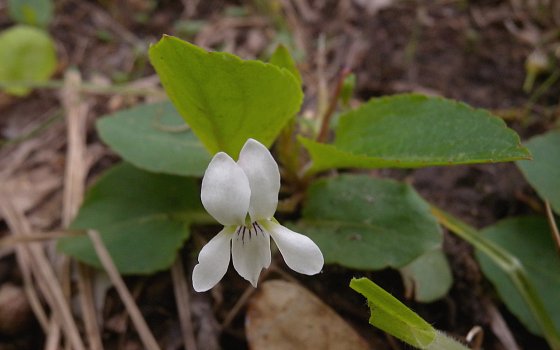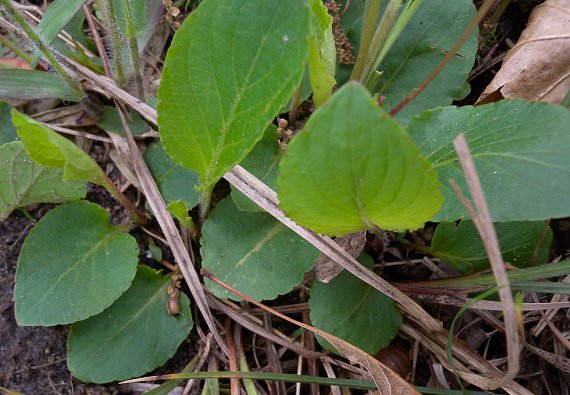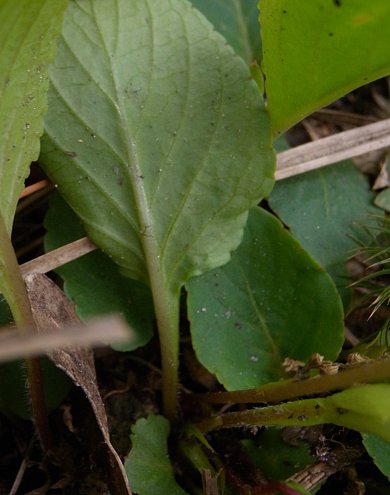
Each flower is about ½" across, consisting of 5 white spreading petals, 5 light green sepals, and the inconspicuous reproductive organs. The lowest petal of each flower has several purple veins and it is beardless (lacking a patch of hairs) at its base. Toward the back of the flower, this petal tapers into a short stout nectar-spur. The two lower lateral petals have either reduced purple veins or they are veinless; their bases are either beardless or slightly bearded. The upper lateral petals lack purple veins and they are always beardless. The sepals are lanceolate and glabrous; the basal lobes of the sepals are short and rounded. The blooming period of these flowers occurs from mid-spring to early summer, lasting about 3-4 weeks. In addition to the showy flowers that have been described, there are also inconspicuous cleistogamous flowers that are self-fertile; they are produced shortly afterwards. The fertilized showy flowers and cleistogamous flowers are replaced by green seed capsules that become up to ½" long at maturity; they are ovoid-oblongoid in shape and glabrous. At maturity, these capsules divide into 3 parts, flinging their seeds in the process. The small seeds are 1.0–1.5 mm. long and globoid to ovoid in shape. The root system consists of a slender crown with fibrous roots and stolon-like rhizomes; clonal offsets are produced from the rhizomes, causing small colonies of plants to develop.

Cultivation: The preference is partial sun, moist conditions, and sandy soil.
Range & Habitat: Primrose-leaved Violet occurs in only 3 counties of NE Illinois, where it is rare and native (see Distribution Map). It is state-listed as 'endangered.' Outside of Illinois, this violet occurs primarily in sandy areas along the Atlantic coastal plain and Gulf of Mexico region. There is also a variety of this violet that occurs in the Pacific northwest. Habitats include moist sand prairies, sandy shrub prairies, moist sandy savannas, openings in moist sandy woodlands, and sandy paths through wooded areas. Primrose-leaved Violet is found in high quality natural areas, especially where there have been wildfires that reduced overhead woody vegetation. It also adapts to grassy paths in these areas if they are not mowed too often or too low.

Faunal Associations: The flowers of Primrose-leaved Violet probably attract the same, or similar, insect pollinators as other violets with white flowers. Such insects include honeybees, bumblebees, long-horned bees (Synhalonia spp.), mason bees (Osmia spp.), an oligolectic Andrenid bee (Andrena violae), the Giant Bee Fly (Bombylius major), small- to medium-sized butterflies, and skippers (Robertson, 1929). Bees are the most important pollinators. Sometimes ants enter the flowers of violets to feed on nectar, but they are not effective pollinators. Other insects feed on the foliage and other parts of violets. These insect feeders include the caterpillars of several Fritillary butterflies (Boloria spp., Speyeria spp.), larvae of the Violet Sawfly (Ametastega pallipes), the Violet Aphid (Neotoxoptera violae), larvae of the Violet Fruit Midge (Dasineura semenivora) and Violet Gall Midge (Prodiplosis violicola), and a thrips (Odontothrips pictipennis); see Bouseman & Sternburg (2001), Smith (2006), Hottes & Frison (1931), Felt (1917), Aldrich & Osten-Sacken (1905), and Stannard (1968). The seeds of violets are eaten to some extent by such birds as the Ruffed Grouse, Wild Turkey, Bobwhite Quail, Mourning Dove, and Slate-colored Junco; the White-footed Mouse and Woodland Vole also eat the seeds. The Cottontail Rabbit and White-tailed Deer feed on the foliage of violets to a minor extent, as does the Eastern Chipmunk and Wood Turtle (Clemmys insculpta); see Martin et al. (1951/1961), Augustine (1997), Wrazen & Svendsen (1978), and Ernst et al. (1994).

Photographic Location: Grassy paths through moist sandy savannas and moist sandy woodlands at the Iroquois County Conservation Area in Illinois.
Comments: This is one of the smaller violets with dainty flowers and foliage. It remains inconspicuous, except when it blooms. Primrose-leaved Violet (Viola primulifolia) is probably a naturally occurring hybrid of two other native violets, Lance-leaved Violet (Viola lanceolata) and Small White Violet (Viola macloskeyi pallens). As a result, some authorities refer to Primrose-leaved Violet as a hybrid, or Viola × primulifolia. This violet can be distinguished from other violets (Viola spp.) by its white flowers and the shape of its leaves. These leaves are more broad than those of Lance-leaved Violet, but they are less orbicular in shape than those of Small White Violet. The Sand Violet (Viola fimbriatula) has leaves that are similar in shape to those of Primrose-leaved Violet, but the foliage of Sand Violet is usually more pubescent and its flowers are blue-violet. Across its range, the Primrose-leaved Violet is somewhat variable in the pubescence of its foliage. In the northern parts of its range (including Illinois), the foliage of this violet is mostly glabrous, but in the southern parts of its range (e.g., in SE United States), its foliage is more pubescent.